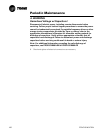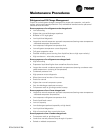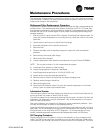
156 RTAC-SVX01F-EN
Maintenance Procedures
• Low oil sump level after normal shut down
• Lower than normal oil concentrations in evaporator
R134a Field Charging Procedure
Be certain that the electrical power to the unit is disconnected before performing this
procedure.
ƽ WARNING
Hazardous Voltage w/Capacitors!
Disconnect all electric power, including remote disconnects before
servicing. Follow proper lockout/tagout procedures to ensure the power
cannot be inadvertently energized. For variable frequency drives or other
energy storing components provided by Trane or others, refer to the
appropriate manufacturer’s literature for allowable waiting periods for
discharge of capacitors. Verify with an appropriate voltmeter that all
capacitors have discharged. Failure to disconnect power and discharge
capacitors before servicing could result in death or serious injury.
Note: For additional information regarding the safe discharge of
capacitors, see PROD-SVB06A-EN or PROD-SVB06A-FR
Factory (initial) Refrigerant Charging Procedure
The initial charging procedure should be followed the first time the unit is charged in
the factory, as well as for charging any time after the charge has been completely
removed from the entire system in the event of repair.
1. As part of automatic vacuum/charge procedure, verify that the EXVs are OPEN.
2. Attach vacuum hoses to evaporator service valves (one per circuit). Open service
valves.
3. Attach charging hoses to the charging port on the liquid line filter (one per circuit).
The filters contain a port with a ¼” (6mm) flare.
4. Begin semi-automatic vacuum procedure.
5. When vacuum is complete (indicated), manually isolate the unit from vacuum.
6. Charge unit through the filter housing port per Table 1 - Table 5.
7. When charging is complete, shut evaporator service valve and disconnect
vacuum and charging hoses.
Field Refrigerant Charging Procedure
Follow this procedure when the unit is empty of all refrigerant and under a vacuum.
Add the charge through the evaporator service valve.
CAUTION
Evaporator Damage!
Water must be flowing through the evaporator during the entire
charging process to avoid freezing and rupturing of the evaporator tubes.
Charge first with vapor to avoid freezing tubes.
1. Note the weight of the amount of charge removed. Compare it to Table 1 - Table
5. A difference in charge may indicate a leak.


















